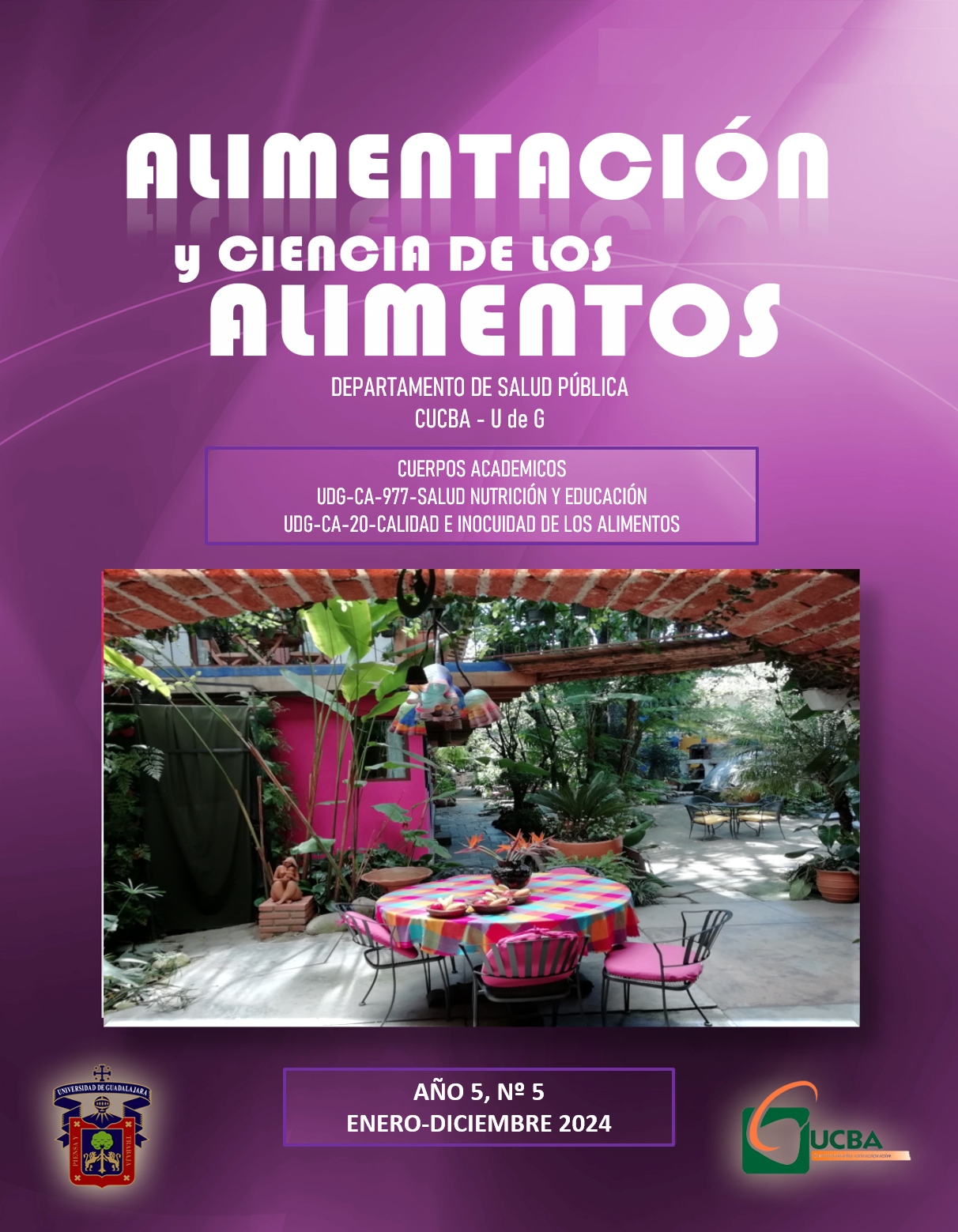Efecto inhibitorio de fracciones peptídicas obtenidas por ultrafiltración de hidrolizados proteínicos de frijol caupí (Vigna unguiculata), sobre la renina
DOI:
https://doi.org/10.32870/rayca.v5i5.78Palabras clave:
Vigna unguiculata, renina, hipertensión, péptidos bioactivos, hidrólisis enzimática, ultrafiltración.Resumen
El sistema renina-angiotensina-aldosterona (SRAA) es clave en la fisiopatología de la hipertensión arterial. La renina regula la cascada del SRAA al convertir el angiotensinógeno en angiotensina I, que es una molécula relativamente inactiva. En la presente investigación, se realizó la evaluación in vitro de la actividad inhibitoria de la renina de fracciones peptídicas obtenidas mediante hidrólisis enzimática de la proteína de Vigna unguiculata. La proteína de frijol caupí se hidrolizó con cada uno de dos sistemas enzimáticos, pepsina-pancreatina o Flavourzyme®. La ultrafiltración de los hidrolizados produjo fracciones de diferentes pesos moleculares. La fracción >5 kDa del hidrolizado con Flavourzyme® tuvo la mayor actividad inhibidora de renina con 50,52 % mientras que para el hidrolizado de pepsina-pancreatina, la fracción >10 kDa fue la mejor con 33,46 % de inhibición de renina. Las fracciones peptídicas de los hidrolizados de proteínas de Vigna unguiculata exhibieron actividad antihipertensiva y tienen potencial aplicación como ingredientes en alimentos funcionales.
Citas
Aluko, R. E. (2019). Food protein-derived renin-inhibitory peptides: in vitro and in vivo properties. Journal of Food Biochemistry, 43, e12648. https://doi.org/10.1111/jfbc.12648
Castañeda-Pérez, E., Jiménez-Morales, K., Castellanos-Ruelas, A. Chel-Guerrero, L., & Betancur-Ancona, D. (2021). Antidiabetic potential of protein hydrolysates and peptide fractions from Lima bean (Phaseolus lunatus L): An in vitro study. International Journal of Peptide Research and Therapeutic, 27, 1979-1988. https://doi.org/10.1007/s10989-021-10226-8
Chen, Y., Meng, L., Shao, H., & Yu, F. (2013). Aliskiren vs. other antihypertensive drugs in the treatment of hypertension: a meta-analysis. Hypertension Research, 36, 252–261. https://doi.org/10.1038/hr.2012.185
Ciau-Solís, N.A., Acevedo‐Fernández, J.J., & Betancur‐Ancona, D. (2018). In vitro renin-angiotensin system inhibition and in vivo antihypertensive activity of peptide fractions from lima bean (Phaseolus lunatus L.). Journal of the Science and Food Agriculture, 98, 781-786. https://doi.org/10.1002/jsfa.8543
Ciau-Solís, N., & Betancur-Ancona, D. (2021). Sistema renina-angiotensina (SRA) en las patologías cardiovasculares: papel sobre la hipertensión arterial. Journal of Negative and Non Positive Results, 6(1), 163-76. https://doi.org/10.19230/jonnpr.3712
Cú-Cañetas, T., Betancur-Ancona. D., Gallegos-Tintoré, S., Sandoval-Peraza, M., & Chel- Guerrero, L. (2015). Estudios de inhibición in vitro de la enzima convertidora de angiotensina-I, efectos hipotensor y antihipertensivo de fracciones peptídicas de V. unguiculata. Nutrición Hospitalaria, 32(5), 2117-2125. https://dx.doi.org/10.3305/nh.2015.32.5.9624
Girgih, A.T., Nwachukwu, I.D., Hasan, F., Fagbemi, T.N., Gill, T., & Aluko, R.E. (2015). Kinetics of the inhibition of renin and angiotensin I-converting enzyme by cod (Gadus morhua) protein hydrolysates and their antihypertensive effects in spontaneously hypertensive rats. Food & Nutrition Research, 59, 2978. https://doi.org/10.3402/fnr.v59.29788
Gonçalves, F.V., Medici, L.O., Da Fonseca, M.P.S. Gaziola, S.A., Lima, G.R., Macedo, D.C., & Azevedo, R.A. (2020). Characterization of the development of Cowpea cultivars and of the quantity and quality of proteins in their grains. Pesquisa Agropecuária Brasileira, 55, e00837, https://doi.org/10.1590/S1678-3921.pab2020.v55.00837
Li, H., & Aluko, R. (2010). Identification and inhibitory properties of multifunctional peptides from pea protein hidrolysate. Journal of Agricultural and Food Chemistry, 58, 11471-11476. https://doi.org/10.1021/jf102538g
Malomo, S.A., Nwachukwu, I.D., Girgih, A.T., Idowu, A.O., Aluko, R.E., & Fagbemi, T.N. (2020). Antioxidant and renin-angiotensin system inhibitory properties of Cashew Nut and Fluted-Pumpkin protein hydrolysates. Polish Journal of Food and Nutrition Sciences, 70(3), 275-289. https://doi.org/10.31883/pjfns/122460
Montgomery D.C. (2020). Design and analysis of experiments. Hoboken, NJ, USA; Wiley & Sons; pp. 408-72.
Mueed, A., Shibli, S., Korma, S.A., Madjirebaye, P., Esatbeyoglu, T., & Deng, Z. (2022). Flaxseed bioactive compounds: Chemical composition, functional properties, Food Applications and Health Benefits-Related Gut Microbes. Foods, 11(20), 3307-3332. https://doi.org/10.3390/foods11203307
Nardo, A.E., Suárez, S., Quiroga, A.V., & Añon, M.C. (2020). Amaranth as a source of antihypertensive peptides. Frontiers in Plant Science, 11, 578631. https://doi.org/10.3389/fpls.2020.578631
NCD-RisC. (2017). Worldwide trends in blood pressure from 1975 to 2015: a pooled analysis of 1479 population-based measurement studies with 19·1 million participants. Lancet, 7, 389(10064), 37-55. https://doi.org/10.1016/S0140-6736(16)31919-5
Nielsen, P.M., Petersen, D., & Dambmann, C. (2001). Improved method for determining food protein degree of hydrolysis. Journal of Food Science, 66, 642-646. https://doi.org/10.1111/j.1365-2621.2001.tb04614.x
Pihlanto, A., y Makinen, S. (2017). The function of renin and the role of food‐derived peptides as direct renin inhibitors. In A. Tolekova (Ed.), Renin‐angiotensin system‐past, present and future IntechOpen. (pp. 241–258). http://dx.doi.org/10.5772/intechopen.69513
Quiroga, A.V., Aphalo, P., Nardo, A.E., & Añon, M. C. (2017). In vitro modulation of renin-angiotensin system enzymes by Amaranth (Amaranthus hypochondriacus) protein derived peptides: Alternative mechanisms different from ACE Inhibition. Journal of Agricultural and Food Chemistry. 65(34), 7415-7423. https://doi.org/10.1021/acs.jafc.7b02240
Ramya, K., Suresh, R., Kumar, H.Y., Kumar, B.R.P., & Murthy, N.B.S. (2020). Decades-old renin inhibitors are still struggling to find a niche in antihypertensive therapy. A fleeting look at the old and the promising new molecules. Bioorganic & Medicinal Chemistry, 28(10), 115466. https://doi.org/10.1016/j.bmc.2020.115466
Satpathy, L., Dash, D., Sahoo, P., Anwar, T.N., & Parida, S.P. (2020). Quantitation of total protein content in some common edible food sources by Lowry protein assay. Letters in Applied NanoBioScience, 9(3), 1275-1283. https://doi.org/10.33263/LIANBS93.12751283
Segura-Campos, M., Ruiz-Ruiz, J., Chel-Guerrero, L., & Betancur-Ancona, D. (2012). Antioxidant activity of Vigna unguiculata L. walp and hard-to-cook Phaseolus vulgaris L. protein hydrolysates, CyTA-Journal of Food, 11(3), 208-215, https://doi.org/10.1080/19476337.2012.722687
Udenigwe, C. C., Lin, Y.‐S., Hou, W.C., & Aluko, R. E. (2009). Kinetics of the inhibition of renin and angiotensin I‐converting enzyme by flaxseed protein hydrolysate fractions. Journal of Functional Foods, 1(2), 199-207. https://doi.org/10.1016/j.jff.2009.01.009
World Health Organization. (2020). WHO reveals leading causes of death and disability worldwide 2000-2019. who.int https://www.who.int/es/news/item/09-12-2020-who-reveals-leading-causes-of-death-and-disability-worldwide-2000-2019






